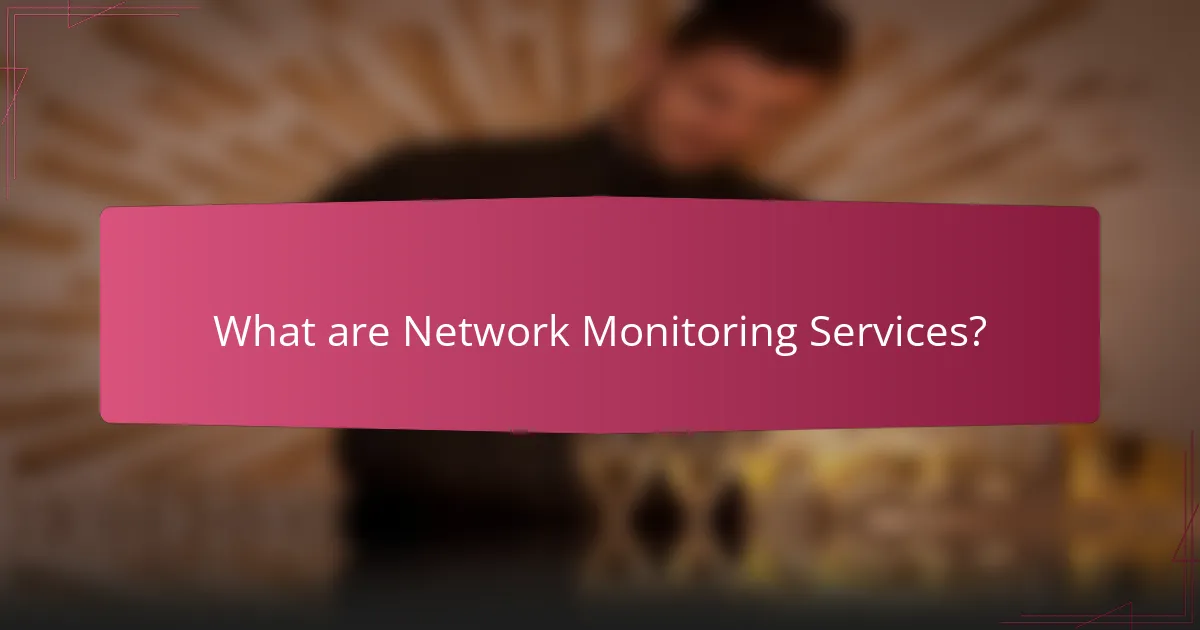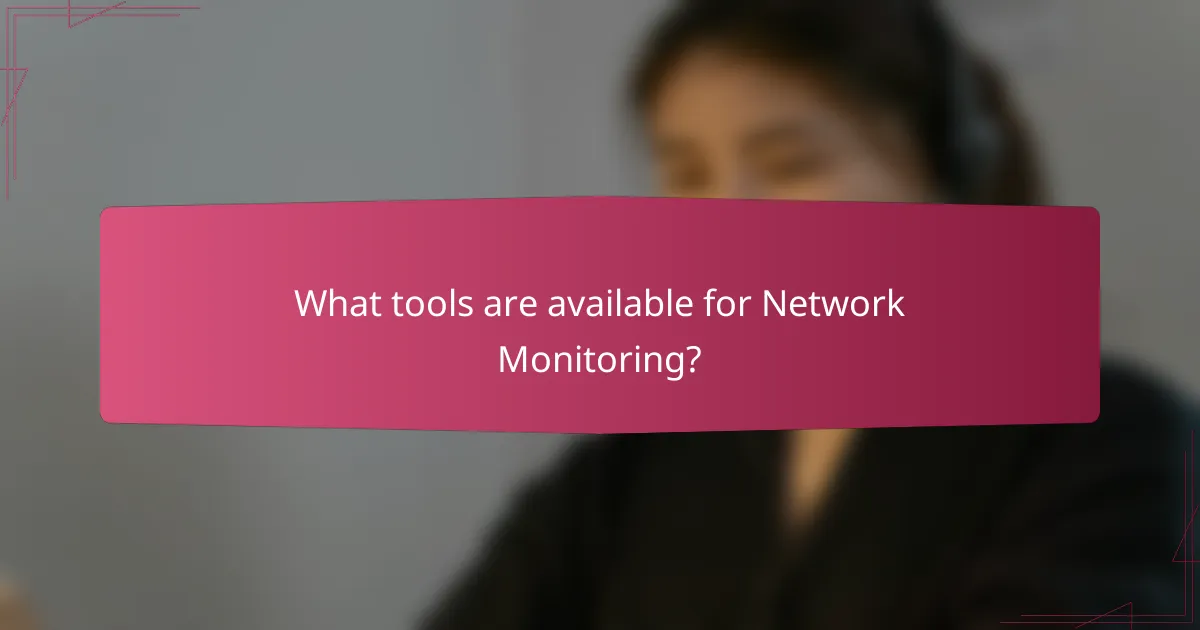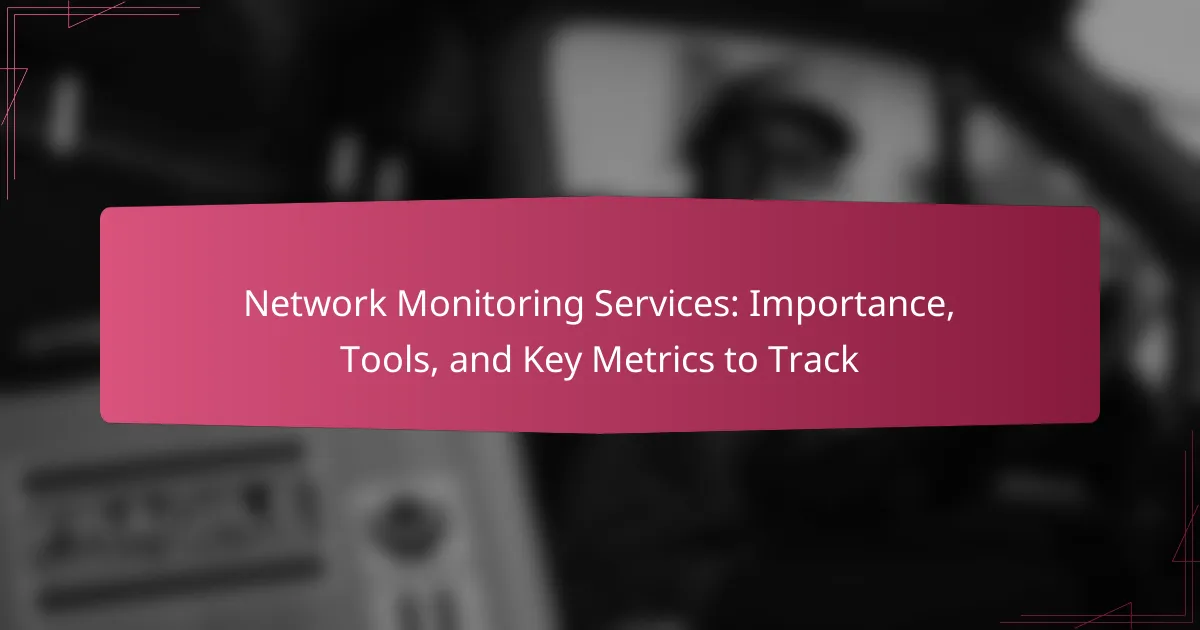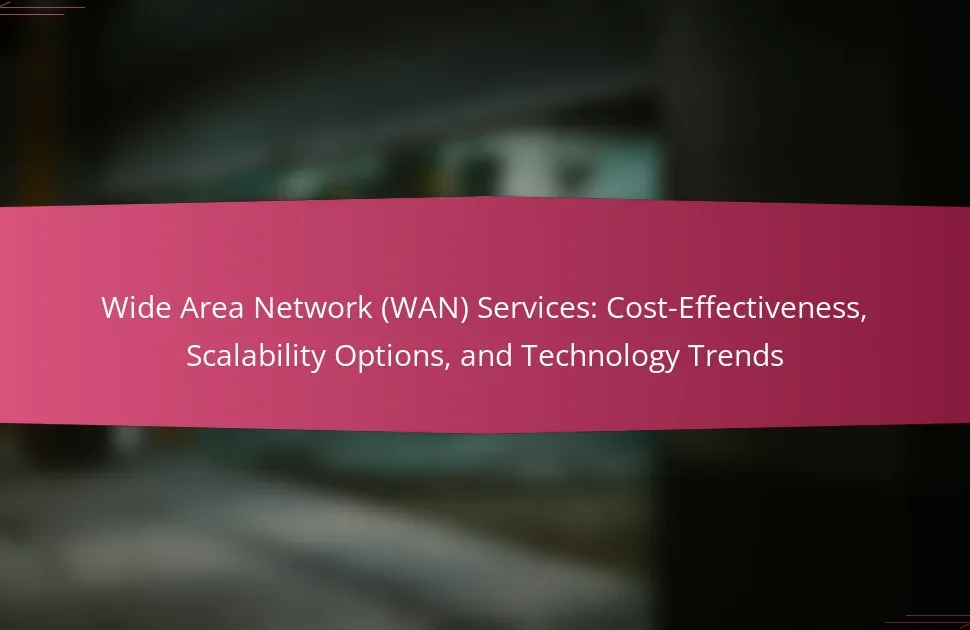
What are Network Monitoring Services?
Network monitoring services are tools that track the performance and health of a computer network. They provide real-time data on network traffic, device status, and potential issues. These services help identify bottlenecks and outages. They also ensure optimal network performance and security. Network monitoring can reduce downtime and improve user experience. Various tools are available for network monitoring, including software and hardware solutions. Many organizations rely on these services to maintain efficient operations. Studies show that effective network monitoring can lead to a 50% reduction in downtime.
How do Network Monitoring Services function?
Network monitoring services function by continuously observing network performance and health. They utilize specialized software tools to collect data on traffic, device status, and potential issues. These tools analyze metrics such as bandwidth usage, latency, and packet loss. Alerts are generated when anomalies or performance thresholds are exceeded. The services often provide real-time dashboards for visualization. Historical data is stored for trend analysis and reporting. This proactive approach helps in identifying and resolving issues before they impact users. According to a 2021 report by Gartner, effective network monitoring can reduce downtime by up to 40%.
What technologies are utilized in Network Monitoring Services?
Network monitoring services utilize various technologies to ensure network performance and security. These include network performance monitoring tools, which analyze traffic patterns and detect anomalies. Protocol analyzers capture and interpret data packets traversing the network. SNMP (Simple Network Management Protocol) facilitates communication between network devices for monitoring purposes. Additionally, flow monitoring technologies, such as NetFlow and sFlow, provide insights into bandwidth usage. Network intrusion detection systems (NIDS) monitor for suspicious activity. Log management tools collect and analyze event logs for troubleshooting and compliance. Finally, cloud-based monitoring solutions offer scalability and remote access to monitoring data. These technologies collectively enhance visibility and control over network environments.
What roles do network protocols play in monitoring?
Network protocols are essential for monitoring network performance and security. They facilitate communication between devices, enabling data exchange for analysis. Protocols like SNMP (Simple Network Management Protocol) allow for the collection of device statistics. This includes metrics such as bandwidth usage and error rates. Monitoring tools utilize these protocols to gather real-time data. This data helps in identifying network issues and optimizing performance. Furthermore, protocols ensure that alerts are sent for any anomalies detected. Effective monitoring relies heavily on these protocols to maintain network health.
Why are Network Monitoring Services important?
Network monitoring services are important because they ensure the health and performance of IT networks. They provide real-time visibility into network activity and facilitate the detection of issues before they escalate. Proactive monitoring helps prevent downtime, which can lead to significant financial losses. According to a study by Gartner, network downtime can cost businesses up to $5,600 per minute. Additionally, these services enhance security by identifying unauthorized access and potential threats. They also assist in optimizing network performance by analyzing traffic patterns and resource usage. Overall, network monitoring services are crucial for maintaining operational efficiency and safeguarding data integrity.
What risks do Network Monitoring Services mitigate?
Network monitoring services mitigate several risks associated with network performance and security. They help identify and resolve potential outages before they impact users. These services monitor traffic patterns to detect unusual behavior that may indicate a security breach. They also provide insights into bandwidth usage, helping to prevent congestion and optimize resource allocation. By ensuring compliance with security policies, network monitoring services reduce the risk of data breaches. Additionally, they can alert administrators to hardware failures, minimizing downtime. According to a study by Gartner, organizations that implement network monitoring solutions can reduce incident response times by up to 50%.
How do these services enhance network performance?
Network monitoring services enhance network performance by providing real-time visibility into network operations. They detect issues such as bottlenecks and outages promptly. This allows for quicker response times to resolve problems. Monitoring tools analyze traffic patterns and usage statistics. They help identify underutilized resources and optimize bandwidth allocation. Enhanced performance leads to improved user experience and productivity. Studies show that organizations using network monitoring experience fewer downtime incidents. This results in cost savings and better resource management.

What tools are available for Network Monitoring?
Network monitoring tools are essential for managing and optimizing network performance. Common tools include SolarWinds Network Performance Monitor, which provides real-time monitoring and alerts. Another popular option is Nagios, known for its robust monitoring capabilities and customizable alerts. PRTG Network Monitor offers an all-in-one solution with various sensors for monitoring different network aspects. Additionally, Wireshark is a powerful tool for analyzing network traffic in detail. Each of these tools supports network administrators in identifying issues and ensuring optimal network functionality.
What are the most popular Network Monitoring tools?
The most popular network monitoring tools include SolarWinds Network Performance Monitor, Nagios, PRTG Network Monitor, and Zabbix. SolarWinds Network Performance Monitor offers comprehensive monitoring and reporting features. Nagios is known for its powerful alerting capabilities and customizable plugins. PRTG Network Monitor provides an intuitive interface and real-time monitoring. Zabbix is favored for its scalability and open-source flexibility. These tools are widely recognized for their effectiveness in managing network performance and reliability.
How do open-source tools compare to commercial solutions?
Open-source tools typically offer lower costs compared to commercial solutions. They allow users to modify and customize the software to meet specific needs. Users benefit from community support and collaboration, which can lead to rapid development and innovation. However, commercial solutions often provide dedicated support and comprehensive documentation. They may also include user-friendly interfaces and advanced features. According to a 2021 report by Gartner, 70% of enterprises prefer commercial solutions for their reliability and support. Open-source tools can require more technical expertise to implement effectively. Ultimately, the choice depends on budget, expertise, and specific requirements.
What features should be considered when selecting a tool?
When selecting a tool for network monitoring, consider features such as scalability, ease of use, and real-time monitoring capabilities. Scalability ensures that the tool can grow with your network demands. Ease of use affects the efficiency of your team in utilizing the tool. Real-time monitoring capabilities allow for immediate detection of issues, minimizing downtime. Additionally, integration with existing systems is crucial for seamless operation. Customization options enable tailoring the tool to specific network needs. Reporting and analytics features provide insights into network performance. Lastly, vendor support and community resources are important for troubleshooting and assistance.
How can organizations implement Network Monitoring tools effectively?
Organizations can implement Network Monitoring tools effectively by following a structured approach. First, they should identify their specific monitoring needs and objectives. This involves assessing the network’s size, complexity, and critical components. Next, selecting the right tools is essential. Popular options include SolarWinds, Nagios, and PRTG, which offer various features tailored to different requirements.
After selecting tools, organizations must configure them properly. This includes setting up alerts, thresholds, and dashboards for real-time visibility. Training staff on how to use these tools is crucial for maximizing their effectiveness. Regularly reviewing and updating monitoring strategies ensures they remain aligned with organizational goals.
According to a 2021 report by Gartner, organizations that regularly assess their network monitoring needs see a 30% improvement in incident response times. This highlights the importance of a proactive approach to implementation.
What are the key steps in setting up a monitoring system?
Identify the monitoring requirements based on network objectives. Define metrics and parameters to be monitored. Select appropriate monitoring tools that fit the requirements. Install the monitoring software on relevant devices. Configure the monitoring system to ensure accurate data collection. Set thresholds and alerts for critical metrics. Test the system to verify its functionality and accuracy. Review and adjust the monitoring system regularly to adapt to network changes.
How can teams ensure ongoing effectiveness of the monitoring tools?
Teams can ensure ongoing effectiveness of monitoring tools by regularly updating and configuring them. Consistent updates help maintain compatibility with new technologies and security standards. Regular configuration checks ensure that the tools are tailored to current network requirements. Additionally, teams should conduct routine performance assessments to identify any potential issues. Monitoring tools should be integrated with incident response protocols for timely action. Training staff on tool usage enhances operational efficiency. Finally, collecting feedback from users can highlight areas for improvement. These practices collectively contribute to the sustained effectiveness of monitoring tools.

What key metrics should be tracked in Network Monitoring?
Key metrics to track in network monitoring include bandwidth usage, latency, packet loss, and uptime. Bandwidth usage measures the amount of data transmitted over the network. High bandwidth usage can indicate congestion. Latency refers to the time it takes for data to travel from source to destination. Low latency is crucial for real-time applications. Packet loss measures the percentage of packets that fail to reach their destination. High packet loss can disrupt communication. Uptime indicates the availability of network resources. A high uptime percentage signifies a reliable network. Monitoring these metrics helps identify issues and optimize performance.
What are the essential performance metrics to monitor?
The essential performance metrics to monitor in network monitoring services include bandwidth usage, latency, packet loss, and uptime. Bandwidth usage indicates the amount of data transmitted over the network. Latency measures the time taken for data to travel from source to destination. Packet loss represents the percentage of packets that fail to reach their destination. Uptime reflects the network’s operational status over a specified period. Monitoring these metrics helps identify performance issues and ensures optimal network functionality. Studies show that effective monitoring can reduce downtime by up to 80%.
How is network latency measured and why is it important?
Network latency is measured using tools that calculate the time taken for data to travel between two points in a network. Common methods include ping tests, which send packets to a target and measure the round-trip time. Another method is traceroute, which tracks the path packets take and identifies delays at each hop. Latency is important because it affects the performance of applications and user experience. High latency can lead to delays in data transmission, impacting real-time applications like video conferencing and online gaming. According to a study by Google, reducing latency by even a few milliseconds can significantly improve user engagement and satisfaction.
What does bandwidth utilization indicate about network health?
Bandwidth utilization indicates the efficiency of data transmission within a network. High bandwidth utilization can suggest that the network is being used effectively. However, it may also indicate congestion or potential bottlenecks. Low bandwidth utilization may imply underutilization of resources. This could lead to wasted capacity and increased costs. Monitoring bandwidth utilization helps identify performance issues. It also aids in capacity planning and resource allocation. Regular analysis of bandwidth metrics supports optimal network performance.
How can organizations analyze and interpret monitoring data?
Organizations can analyze and interpret monitoring data by employing various analytical techniques and tools. They can use statistical analysis to identify trends and patterns in the data. Visualization tools, such as dashboards, help in presenting the data clearly. This facilitates easier interpretation of complex information. Machine learning algorithms can also be applied to predict future performance based on historical data.
Data correlation techniques allow organizations to understand relationships between different metrics. Regular reporting and review processes ensure that insights are consistently evaluated. Additionally, organizations can benchmark their data against industry standards to gauge performance. These methods are validated by numerous case studies showing improved operational efficiency through effective data analysis.
What tools assist in data visualization for network metrics?
Tools that assist in data visualization for network metrics include Grafana, Tableau, and Kibana. Grafana is an open-source platform that allows users to create dynamic dashboards. It integrates with various data sources, making it versatile for network metrics. Tableau is a powerful analytics tool that provides interactive data visualization capabilities. It helps in analyzing and presenting network data effectively. Kibana is part of the Elastic Stack and offers visualization for data indexed in Elasticsearch. It is useful for real-time data analysis. These tools enhance understanding of network performance and facilitate informed decision-making.
How can trends in monitoring data inform network improvements?
Trends in monitoring data can inform network improvements by identifying performance bottlenecks. Analyzing data trends reveals consistent patterns in network usage and issues. For example, spikes in latency during specific hours indicate potential congestion. This information allows network administrators to optimize bandwidth allocation. Additionally, monitoring data can highlight recurring outages or failures in certain areas. Addressing these issues can enhance overall network reliability. Furthermore, trends can indicate the need for hardware upgrades based on usage growth. By making data-driven decisions, organizations can improve user experience and operational efficiency.
What best practices should be followed for effective Network Monitoring?
Effective network monitoring requires several best practices. First, establish clear objectives for monitoring. This ensures that the monitoring efforts align with organizational goals. Next, utilize automated monitoring tools. Automation enhances efficiency and reduces human error. Regularly update monitoring tools to maintain effectiveness. Outdated tools may miss critical issues. Implement a comprehensive monitoring strategy. This includes tracking performance, security, and compliance metrics.
Perform regular network assessments to identify vulnerabilities. Assessments help in proactive issue resolution. Set up alerts for unusual activity. Alerts enable quick responses to potential threats. Document all monitoring processes and results. Documentation aids in compliance and future audits. Finally, continuously review and improve monitoring practices. This ensures adaptability to changing network conditions. These practices lead to a more secure and reliable network environment.
How can regular audits improve monitoring processes?
Regular audits enhance monitoring processes by identifying inefficiencies and ensuring compliance. These audits provide a structured assessment of existing monitoring systems. They highlight areas for improvement and optimize resource allocation. Regular audits can reveal gaps in data collection or reporting. This leads to more accurate and timely information. Enhanced accuracy improves decision-making and responsiveness. Studies show that organizations with regular audits experience a 20% increase in operational efficiency. Thus, regular audits are crucial for effective monitoring processes.
What common pitfalls should be avoided in Network Monitoring?
Common pitfalls in network monitoring include lack of proper planning, inadequate tool selection, and failure to establish clear metrics. Poor planning can lead to missed issues and inefficient resource allocation. Choosing the wrong tools may result in incomplete visibility of the network. Without clear metrics, it becomes difficult to assess network performance effectively. Another pitfall is ignoring alerts, which can delay response to critical issues. Additionally, not regularly updating monitoring systems can leave vulnerabilities unaddressed. Lastly, failing to train staff on monitoring tools can hinder effective usage and response.
Network monitoring services are essential tools for tracking the performance and health of computer networks, providing real-time data on traffic, device status, and potential issues. This article covers the importance of these services in preventing downtime and enhancing user experience, as well as the various technologies and tools utilized in network monitoring. Key metrics such as bandwidth usage, latency, and packet loss are discussed, alongside best practices for effective monitoring and common pitfalls to avoid. Additionally, the article explores how organizations can implement monitoring tools effectively to optimize network performance and security.




